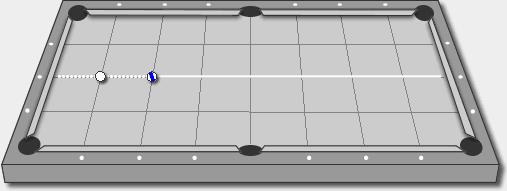 This little shot seems simple, but it's not. Just shoot the cue ball straight
into the object ball, banking it straight back into the cue ball. That
part's fairly easy. The tough part is getting the object ball to hit the
cue ball so full that the cue ball banks back off the end rail and hits
the object ball again. That's three separate collisions, and it's really
tough. I've spent hours at this shot without making it once, and I imagine
I'm about 3 for 500 lifetime on it. Of course the secret is to have the
balls aligned perfectly perpendicular to the rail, and hit the cue ball
exactly on its vertical center. If your table isn't perfectly rectangular,
and your end rails aren't perfectly parallel, this shot is probably impossible.
There are a couple of ways to cheat. To make the second collision more
likely, put follow on the cue ball. This brings the point for the second
collision closer to the far rail. To make the third collision more likely
put draw on the cue ball to bring the potential third collision closer
to the near rail. To make this shot as tough as possible, put the object
ball on the center spot and shoot the cue ball with stop action. I'd bet
big money on people not being able to get three collisions that way.
This little shot seems simple, but it's not. Just shoot the cue ball straight
into the object ball, banking it straight back into the cue ball. That
part's fairly easy. The tough part is getting the object ball to hit the
cue ball so full that the cue ball banks back off the end rail and hits
the object ball again. That's three separate collisions, and it's really
tough. I've spent hours at this shot without making it once, and I imagine
I'm about 3 for 500 lifetime on it. Of course the secret is to have the
balls aligned perfectly perpendicular to the rail, and hit the cue ball
exactly on its vertical center. If your table isn't perfectly rectangular,
and your end rails aren't perfectly parallel, this shot is probably impossible.
There are a couple of ways to cheat. To make the second collision more
likely, put follow on the cue ball. This brings the point for the second
collision closer to the far rail. To make the third collision more likely
put draw on the cue ball to bring the potential third collision closer
to the near rail. To make this shot as tough as possible, put the object
ball on the center spot and shoot the cue ball with stop action. I'd bet
big money on people not being able to get three collisions that way.
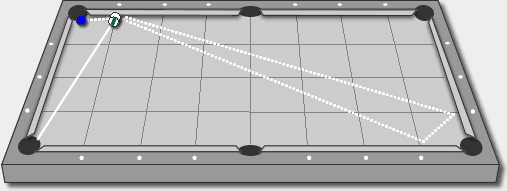 This shot's won me some money, and it's a pretty good practice shot since
to make it requires a pretty good stroke and a full follow-through. Shoot
the cue ball into the rail just before the second diamond with extreme
low right. Stroked correctly, the cue ball will compress the rail and head
for the other end of the table, where the right (running) english will
send it two rails out of the far corner and back towards where it started
from. With minor adjustment of aim, speed, and english, the cue ball can
be made to squeeze back between the object ball and the rail, kicking it
into the opposite corner, while the cue ball caroms off that ball to pocket
the other one. Give yourself 30 tries to make this one. A much harder variation
is to shoot the shot with a lot more speed so that the outer ball banks
back into the same pocket that the hanging one goes in.
watch me shoot this shot
This shot's won me some money, and it's a pretty good practice shot since
to make it requires a pretty good stroke and a full follow-through. Shoot
the cue ball into the rail just before the second diamond with extreme
low right. Stroked correctly, the cue ball will compress the rail and head
for the other end of the table, where the right (running) english will
send it two rails out of the far corner and back towards where it started
from. With minor adjustment of aim, speed, and english, the cue ball can
be made to squeeze back between the object ball and the rail, kicking it
into the opposite corner, while the cue ball caroms off that ball to pocket
the other one. Give yourself 30 tries to make this one. A much harder variation
is to shoot the shot with a lot more speed so that the outer ball banks
back into the same pocket that the hanging one goes in.
watch me shoot this shot
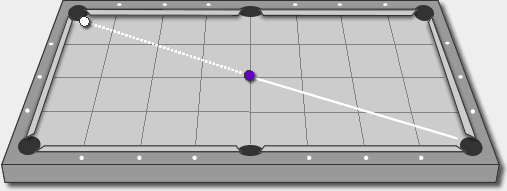 This is my all time favorite alignment fixer. Making the object ball straight
into the corner requires nearly perfect alignment. Once I've found my proper
alignment I can make this shot pretty much at will. For more of a challenge
try following the object ball into the corner, or drawing the cue ball
back to scratch. Try hitting the cue ball with left or right english. Doing
anything wth the cue ball except stopping it dead makes this shot one of
the toughest there is.
This is my all time favorite alignment fixer. Making the object ball straight
into the corner requires nearly perfect alignment. Once I've found my proper
alignment I can make this shot pretty much at will. For more of a challenge
try following the object ball into the corner, or drawing the cue ball
back to scratch. Try hitting the cue ball with left or right english. Doing
anything wth the cue ball except stopping it dead makes this shot one of
the toughest there is.
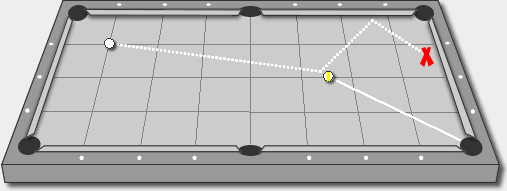 Fire the object ball into lower right the corner while playing the cue
ball off the side rail just below the foot string to the foot rail between
the first and second diamonds. With my balls on my table this requires
a firm hit with the slightest touch of draw. For some reason this shot
has always been a good one for me to use to get a feel for the way a table
plays.
Fire the object ball into lower right the corner while playing the cue
ball off the side rail just below the foot string to the foot rail between
the first and second diamonds. With my balls on my table this requires
a firm hit with the slightest touch of draw. For some reason this shot
has always been a good one for me to use to get a feel for the way a table
plays.
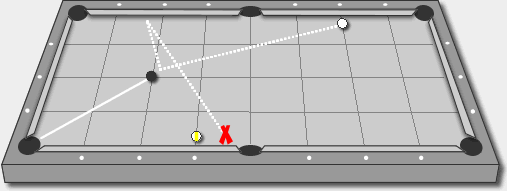 This shot was shown to me by Bryan Roberts of Rack 66 in Louisville. Shoot
a spot shot at the spotted (duh) ball, making it into left-hand corner.
Using straight draw, bring the cue ball off the right side rail and play
shape to make the other ball in the same pocket. The cue ball can't hit
the foot rail, and I doubt too many people that aren't named Efren will
hit the head rail on this one either. Very tough and probably impossible
with dirty balls or slow cloth. When I shoot this shot if I scratch in
the side near the second object ball I'm still happy.
watch me shoot this shot
This shot was shown to me by Bryan Roberts of Rack 66 in Louisville. Shoot
a spot shot at the spotted (duh) ball, making it into left-hand corner.
Using straight draw, bring the cue ball off the right side rail and play
shape to make the other ball in the same pocket. The cue ball can't hit
the foot rail, and I doubt too many people that aren't named Efren will
hit the head rail on this one either. Very tough and probably impossible
with dirty balls or slow cloth. When I shoot this shot if I scratch in
the side near the second object ball I'm still happy.
watch me shoot this shot
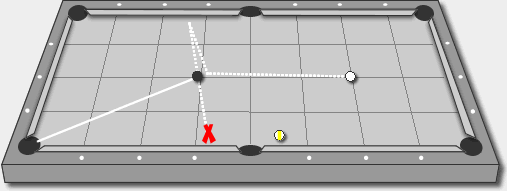 A more realistic variation on the previous shot. I'll call this the Earl
Strickland shot because I saw Earl make this about 800 times in a row while
warming up for a tournament match in Louisville. Just pocket the ball and,
using straight draw, get position on the next ball as shown.
A more realistic variation on the previous shot. I'll call this the Earl
Strickland shot because I saw Earl make this about 800 times in a row while
warming up for a tournament match in Louisville. Just pocket the ball and,
using straight draw, get position on the next ball as shown.
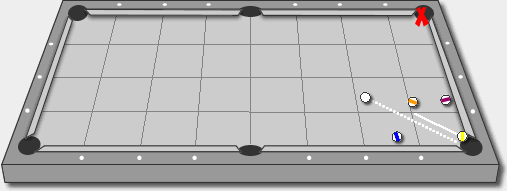 Just a nifty little one-pocket shot that sometimes works on tight-pocketed
tables like my Diamond. My pocket is the one with the X, I need
all the balls and my opponent needs one. It's a pretty hopeless situation
but there is a shot that's at least worth trying. Using just draw, try
to scratch past the jawed ball. If the pockets are tight enough you can
sometimes bring the jawed ball out of your opponent's pocket and leave
no easy shot. Better than simply giving up.
watch me shoot this shot
Just a nifty little one-pocket shot that sometimes works on tight-pocketed
tables like my Diamond. My pocket is the one with the X, I need
all the balls and my opponent needs one. It's a pretty hopeless situation
but there is a shot that's at least worth trying. Using just draw, try
to scratch past the jawed ball. If the pockets are tight enough you can
sometimes bring the jawed ball out of your opponent's pocket and leave
no easy shot. Better than simply giving up.
watch me shoot this shot
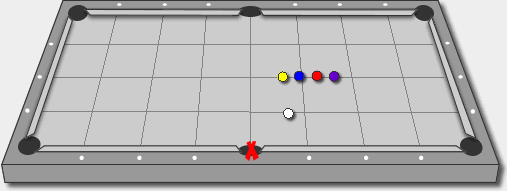 Practice for bank pool. Take ball-in-hand, then bank the balls cross-side
in order, shooting the two, three, and four from wherever the cueball stops.
I've found it easier to shoot this drill by drawing the cueball back to
the side rail and letting it bounce out for position instead of just trying
to get position directly. By using the cushion you can use english to make
small adjustments to the angle for your next shot.
watch me shoot these shots
Practice for bank pool. Take ball-in-hand, then bank the balls cross-side
in order, shooting the two, three, and four from wherever the cueball stops.
I've found it easier to shoot this drill by drawing the cueball back to
the side rail and letting it bounce out for position instead of just trying
to get position directly. By using the cushion you can use english to make
small adjustments to the angle for your next shot.
watch me shoot these shots
 Good One Pocket practice. Take ball in hand and shoot the object ball
into the corner. Try to draw the cueball straight back so that you can
spot another object ball and shoot IT into the corner. Repeat. If you get
out of line use cushions, rails, and speed as needed to get back into position.
Good One Pocket practice. Take ball in hand and shoot the object ball
into the corner. Try to draw the cueball straight back so that you can
spot another object ball and shoot IT into the corner. Repeat. If you get
out of line use cushions, rails, and speed as needed to get back into position.
 A much tougher version of one of my crucial bank shots on this
page. Jack up and strive to hit the cueball low and with a little
bit of inside english. Without the inside english the cueball is likely
to drift over and interfere with the rebounding object ball, but you
can get away without it on some equipment. Also on some equipment the
shot can be made using a high-outside hit and hoping you transfer enough
spin to the object ball. Put a patch of cloth under the cueball when
practicing this shot.
watch me shoot this shot
A much tougher version of one of my crucial bank shots on this
page. Jack up and strive to hit the cueball low and with a little
bit of inside english. Without the inside english the cueball is likely
to drift over and interfere with the rebounding object ball, but you
can get away without it on some equipment. Also on some equipment the
shot can be made using a high-outside hit and hoping you transfer enough
spin to the object ball. Put a patch of cloth under the cueball when
practicing this shot.
watch me shoot this shot

 A couple of neat shots when they come up. Feel free to imagine blocking
balls that make other options impractical. The 3-bank option is cut slightly
more than the 2-bank option. No english is needed, but a little draw can
avoid the scratch in the corner.
watch me shoot this shot
A couple of neat shots when they come up. Feel free to imagine blocking
balls that make other options impractical. The 3-bank option is cut slightly
more than the 2-bank option. No english is needed, but a little draw can
avoid the scratch in the corner.
watch me shoot this shot
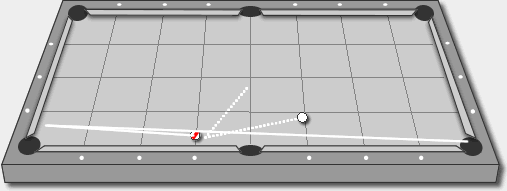 This shot would be on the crucial banks page
except for two things; the tournament that inspired that page did not feature
a lot of these banks, and a pool legend told me that he only expected to
make this shot 50% of the time. This shot can be made with follow or draw
depending on where other balls are. In an end-game situation I like to
use top, trying to get the object ball to just barely make it to the pocket,
and leaving the cueball at the other end of the table if I miss.
watch me shoot this shot
This shot would be on the crucial banks page
except for two things; the tournament that inspired that page did not feature
a lot of these banks, and a pool legend told me that he only expected to
make this shot 50% of the time. This shot can be made with follow or draw
depending on where other balls are. In an end-game situation I like to
use top, trying to get the object ball to just barely make it to the pocket,
and leaving the cueball at the other end of the table if I miss.
watch me shoot this shot
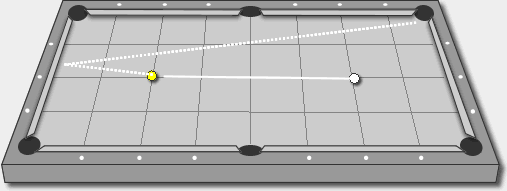 My multi-purpose bank practice shot. I use this to get myself in tune
with how a table is playing. This shot can be made into either corner with
any english and/or speed. The goal is not necessarily to make the shot
every time, but rather to get a feel for how much the balls are grabbing,
how banks are shortening up or lengthening out, and to just generally get
loosened up.
My multi-purpose bank practice shot. I use this to get myself in tune
with how a table is playing. This shot can be made into either corner with
any english and/or speed. The goal is not necessarily to make the shot
every time, but rather to get a feel for how much the balls are grabbing,
how banks are shortening up or lengthening out, and to just generally get
loosened up.
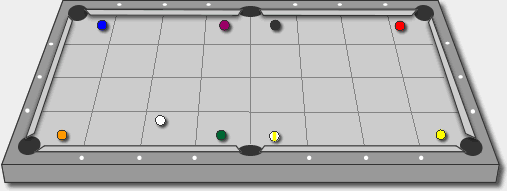 If you can bank all eight balls here you're doing better than I can. What
I recommend is to pick any four balls - the four near the corners, the
four near the sides, or whatever, and bank each cross-table. I've found
this to be the most difficult with the four balls near the side pockets,
but none of these arrangements are as easy as they would first appear to
be. Each ball is one ball-width from the cushion and one-half diamond from
the pocket. This drill - in all its variations - is very fun but very frustrating.
watch me shoot these shots
If you can bank all eight balls here you're doing better than I can. What
I recommend is to pick any four balls - the four near the corners, the
four near the sides, or whatever, and bank each cross-table. I've found
this to be the most difficult with the four balls near the side pockets,
but none of these arrangements are as easy as they would first appear to
be. Each ball is one ball-width from the cushion and one-half diamond from
the pocket. This drill - in all its variations - is very fun but very frustrating.
watch me shoot these shots
more structured practice
I've also developed some more structured practice routines, and I've listed them below. Back when I had more free time I'd try to run through them all in order, but would usually end up skipping a step or two. These days I pretty much stick with one theme for any given practice session.
- The long straight aligmnent checker (shown above, 3rd shot from the top) until I get it 15 times.
- A shotmaker's workout similar to the one from from Bert Kinnister, There are 10 shots. I shoot each shot until I make it 5 times in a row, then reverse the cut angle and shoot that way until I make it 5 times in a row.
- Play God straight pool to 50, ball in hand on the first break shot. If I miss I start over and keep trying until I run 50.
- Play God nine ball race to 5, with breaks not counting and ball in hand after the break. Safety option in effect.
- Play God eight ball race to 5, breaks don't count, ball in hand after the break. Safety option in effect.
- Play God short rack bank pool, ball in hand after the break, until I win a game by banking 5 in a row.
- I hesitate to mention this, but I've also started playing bowlliards again, and I've invented a new variation blending bank pool and bowlliards. I hesitate to mention this because my scores are awful and I may stop at any time.
On those rare days when get through all these I usually feel pretty good about myself. If I still feel like playing I'll either work on shots that have been giving me trouble, just goof around, or do some connect the dots practice.





